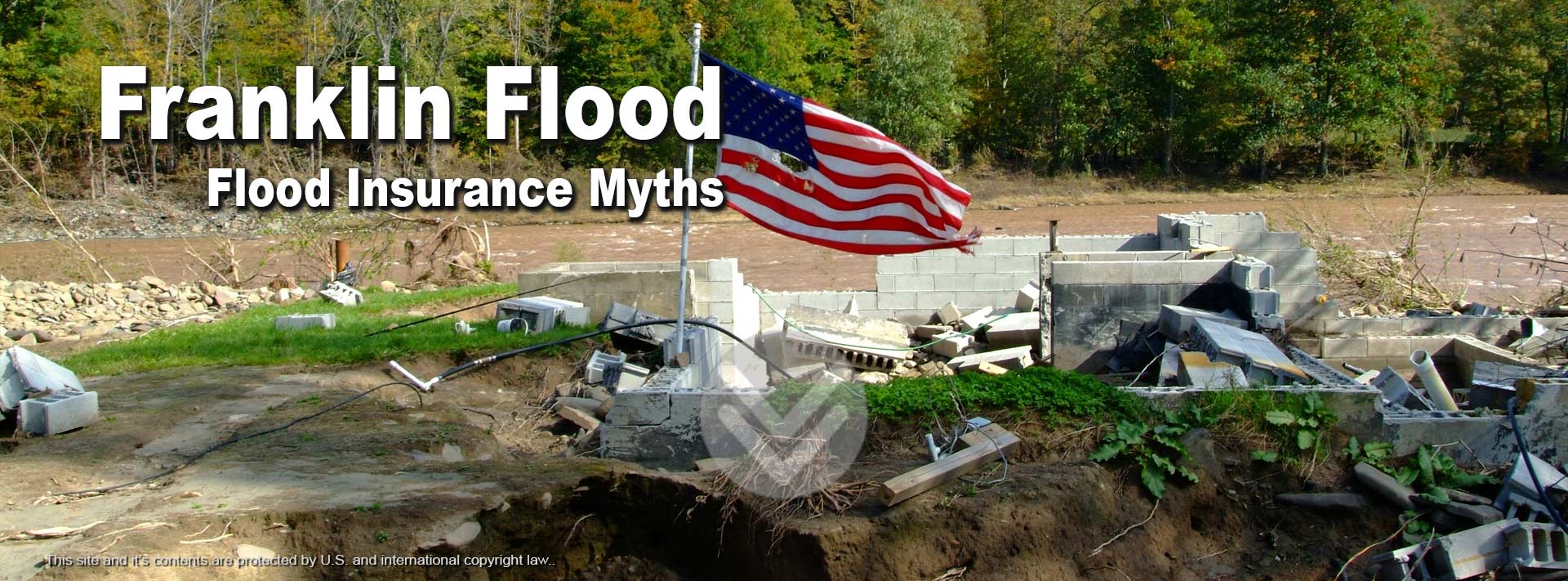The National Flood Insurance Program, NFIP has compiled the following list of common myths about the National Flood Insurance program and the truth behind the myths, to give you the full story about buying flood insurance.
MYTH: You can’t get flood insurance if you are located in a high-flood-risk area.
TRUTH: You can get National Flood Insurance no matter where you live if your community participates in the NFIP, except in Coastal Barrier Resources System (CBRS) areas. The Program was created in 1968 to make federally backed flood insurance available to property owners who live in eligible communities. Flood insurance was then virtually unavailable from the private insurance industry. The Flood Disaster Protection Act of 1973, as amended, requires federally regulated lending institutions to make sure that mortgage loans secured by buildings in high-flood-risk areas are protected by flood insurance. Lenders should notify borrowers, prior to closing, that their property is located in a high-flood-risk area and that National Flood Insurance is required.
MYTH: You can’t get flood insurance immediately before or during a flood.
TRUTH: You can get National Flood Insurance at any time. However, there is a 30-day waiting period after premium payment before the policy is effective, with the following exceptions:
1. If the initial purchase of flood insurance is in connection with the making, increasing, extending, or renewing of a loan, there is no waiting period. Coverage becomes effective at the time of the loan, provided application and payment of premium is made at or prior to loan closing.
2. If the initial purchase of flood insurance is made during the 13-month period following the effective date of a revised flood map for a community, there is a 1-day waiting period. This applies only where the Flood Insurance Rate Map (FIRM) is revised to show the building to be in a Special Flood Hazard Area (SFHA) when it had not been in an SFHA. The policy does not cover a "loss in progress," defined by the NFIP as a loss occurring as of 12:01 a.m. on the first day of the policy term. In addition, you cannot increase the amount of insurance coverage you have during a loss in progress.
MYTH: Homeowners insurance policies cover flooding.
TRUTH: Unfortunately, many home and business owners do not find out until it is too late that their homeowners and business multi-peril policies do not cover flooding. The NFIP offers a separate policy that protects the single most important financial asset, which for most people is their home or business. Homeowners can include contents coverage in their NFIP policy. Residential and commercial renters can purchase contents coverage. Business owners can purchase flood insurance coverage for their buildings and contents/inventory and, by doing so, protect their livelihood.
MYTH: Flood insurance is only available for homeowners.
TRUTH: Most people who live in NFIP participating communities, including renters and condo unit owners, are eligible to purchase federally backed flood insurance. A maximum of $250,000 of building coverage is available for single-family residential buildings; $250,000 per unit for residential condominiums. The limit for contents coverage on all residential buildings is $100,000, which is also available to renters. Commercial structures can be insured to a limit of $500,000 for the building and $500,000 for the contents. The maximum insurance limit may not exceed the insurable value of the property.
MYTH: You can’t buy flood insurance if your property has been flooded.
TRUTH: You are still eligible to purchase flood insurance after your home, apartment, or business has been flooded, provided that your community is participating in the NFIP.
MYTH: Only residents of high-flood-risk areas need to buy flood insurance.
TRUTH: All areas are susceptible to flooding, although to varying degrees. If you live in a low-to-moderate flood risk area, it is advisable to have flood insurance. Between 20 and 25 percent of the NFIP’s claims come from outside high-flood-risk areas. Residential and commercial property owners located in low-to-moderate risk areas should ask their agents if they are eligible for the Preferred Risk Policy, which provides very inexpensive flood insurance protection.
MYTH: Federal disaster assistance will pay for my flood damage.
TRUTH: Before a community is eligible for disaster assistance, it must be declared a federal disaster area. Federal disaster assistance declarations are issued in less than 50 percent of flooding events. The premium for an NFIP policy, averaging a little over $675 a year, can be less expensive than the monthly payments on a federal disaster loan. Furthermore, if you are uninsured and receive federal disaster assistance after a flood, you must purchase flood insurance to remain eligible for future disaster relief.
MYTH: National Flood Insurance can only be purchased through the NFIP directly.
TRUTH: NFIP flood insurance is sold through private insurance companies like Franklin and is backed by the federal government.
MYTH: The NFIP does not offer any type of basement coverage.
TRUTH: Yes it does. The NFIP defines a basement as any area of a building with a floor that is below ground level on all sides. While flood insurance does not cover basement improvements (such as finished walls, floors, or ceilings), or personal belongings kept in a basement (such as furniture and other contents), it does cover structural elements and essential equipment.
The following items are covered under building coverage, as long as they are connected to a power source, if required, and installed in their functioning location:
• Sump pumps
• Well water tanks and pumps, cisterns, and the water in them
• Oil tanks and the oil in them, natural gas tanks and the gas in them
• Pumps and/or tanks used in conjunction with solar energy
• Furnaces, water heaters, air conditioners, and heat pumps
• Electrical junction and circuit breaker boxes and required utility connections
• Foundation elements
• Stairways, staircases, elevators, and dumbwaiters
• Unpainted drywall walls and ceilings, including fiberglass insulation Cleanup
The following items are covered under contents coverage
• Clothes washers and dryers
• Food freezers and the food in them
• The NFIP recommends both building and contents coverage for the broadest protection.
MYTH: The NFIP encourages coastal development.
TRUTH: One of the NFIP’s primary objectives is to guide development away from high-flood-risk areas. NFIP regulations minimize the impact of structures that are built in SFHAs by requiring them not to cause obstructions to the natural flow of floodwaters. Also, as a condition of community participation in the NFIP, those structures built within SFHAs must adhere to strict floodplain management regulations enforced by the community. In addition, the Coastal Barrier Resources Act (CBRA) of 1982 relies on the NFIP to discourage building in fragile coastal areas by prohibiting the sale of flood insurance in designated CBRA areas. While the NFIP does not prohibit property owners from building in these areas, any Federal financial assistance, including federally backed flood insurance, is prohibited. However, the CBRA does not prohibit privately financed development or insurance.
Franklin for Agent Toolbox
Flood Insurance is Affordable Again:
The Homeowner Flood Insurance Affordability Act of 2014 (HFIAA), which went into effect July 1, 2014, restores grandfathering and much of the previous affordable rate structure and more reasonable regulations. For the consumer this means that NFIP Flood Insurance is affordable and obtainable again.
For information talk to a licensed Franklin Flood Insurance Agent TODAY

Franklin Flood, LLC, 120 East Uwchlan Ave, Suite 101, Exton, PA 119341 Toll Free 888 567 9600 Fax 610 524 0900


This site and it's contents are protected by United States and International copyright law. Reproduction without permission is prohibited.




